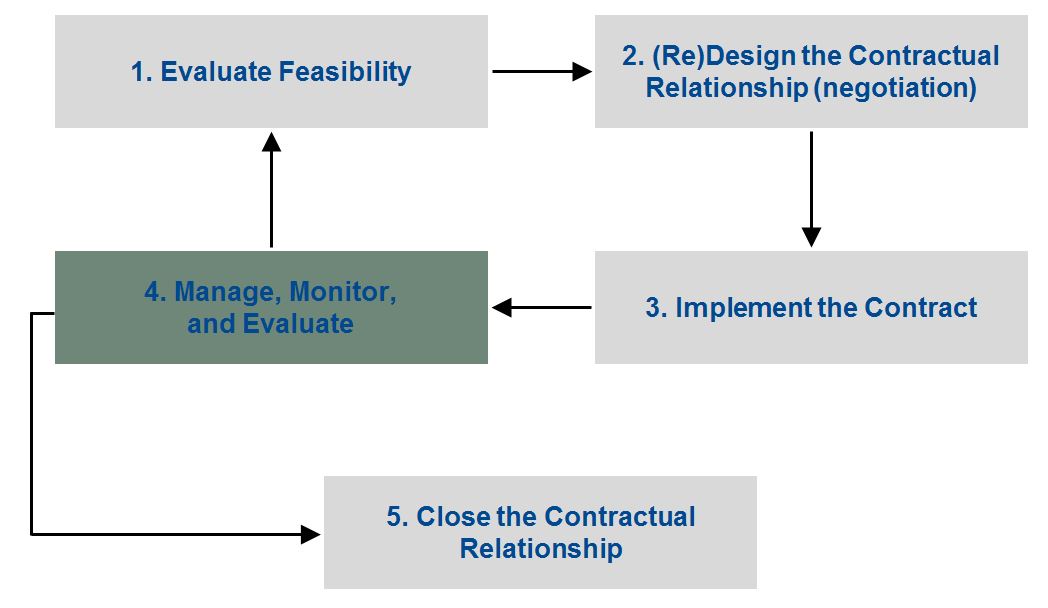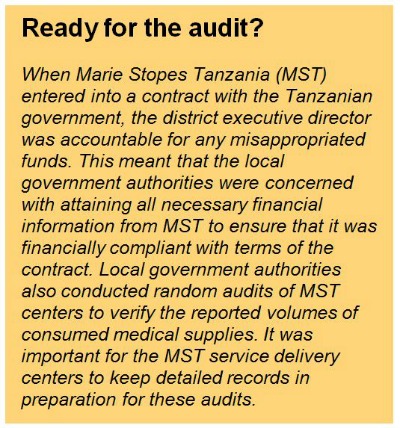Stage Four: Manage, Monitor, and Evaluate

SDOs can expect service contracts to be monitored by purchasers interested in assessing the extent to which family planning services are being delivered with adequate quality and efficiency and that other terms of the agreement are being carried out satisfactorily. For example, monitoring can include number of clients served, percentage of targeted clients served (market share), client satisfaction, periodic assessments of the quality of service provision, and accuracy of documentation and billing.
SDOs will want to monitor purchaser’s performance under the terms of an agreement. For example, monitoring that payments are timely and accurate is critical, as often cash flow under contracts, particularly those with governments, may be delayed or irregular. SDOs should monitor in-force contracts regularly (for example, monthly) to assess the timeliness and adequacy of payments under the contract and the degree of compliance with the financial terms of the contract by both parties to the agreement. The SDO must continuously evaluate whether ongoing delivery of the contracted services is sustainable under the terms of the agreement. Regular meetings (for example, quarterly) with purchaser partners can help address issues or challenges that can arise during the life of the contract.
- 4.1 What is an audit? How should I prepare for performance audits conducted by the purchaser?
- 4.2 What kind of reporting requirements should I expect as part of a contract? How can my SDO benefit from reporting?
- 4.3 The financial compensation under the contract is insufficient - what can the SDO do?
4.1 What is an audit? How should I prepare for performance audits conducted by the purchaser?
 Audits represent a key opportunity for quality monitoring and improvement. SDOs should determine in collaboration with purchasers how audits can be meaningfully and cost-effectively performed, leveraging existing data sources and minimizing ad hoc data collection or analysis.
Audits represent a key opportunity for quality monitoring and improvement. SDOs should determine in collaboration with purchasers how audits can be meaningfully and cost-effectively performed, leveraging existing data sources and minimizing ad hoc data collection or analysis.
Preparation for audits begins by understanding how the parties wish to monitor performance under the contract. Which indicators are relevant? How and in what format will audit data be captured, by whom, and how will those data be used thereafter? How will costs incurred by the SDO (estimated at a percent of an overall budget) to perform audits be recovered?
SDOs should maintain current information on professional staff, including curricula vitae, which can be accessed for proposals and audits. Audits can be scheduled at regular intervals and may also be random.
4.2 What kind of reporting requirements should I expect as part of a contract? How can my SDO benefit from reporting?
Performance monitoring is often used by both the purchaser and the SDO to systematically access the SDO’s performance against agreed-upon requirements. The results from performance monitoring are used to ensure that the contracted activities are performed at the standard set forth in the agreement and can be used, in some cases, to determine compensation and financial rewards. The data collected for performance monitoring and the results generated can also be used by SDOs to strengthen their operations overall. Types of data used for performance monitoring include the demographic characteristics of the client, the client’s symptoms or the reason for the visit, the length of time of the visit, diagnosis, treatment provided, and whether the client was referred to another provider (Liu et al., 2004). Below are examples of clinical and nonclinical indicators commonly used in monitoring and reporting.
Clinical:
- Percent target population served
- Number of clients by type of service, geography, referral source, or other subset
- Number of services provided by client, geography, or other subsetAdverse incidents
- Number of IUDs inserted
Nonclinical:
- Client satisfaction, as evidenced by scores obtained from annual surveys (process, frequency of survey should reflect mutually agreed to terms between the SDO and the purchaser)
- Timeliness of quarterly reports
4.3 The financial compensation under the contract is insufficient—what can the SDO do?
SDOs should negotiate, to the extent possible, provisions in the contract that can trigger additional payment when appropriate. A common way of addressing rising costs is through scheduled increases, which can be tied to inflation or agreed to in advance. Another approach can be to negotiate fixed rates for a reasonable period—for example, one year at a time—with future payment schedules agreed to on a contingent basis.
Such measures help manage risk of forecasting errors, and set the stage to “true up” agreements on an ongoing basis. They also imply that more time should be anticipated by both parties to review and renegotiate terms. A failure to reach agreement on renewal terms could result in contract termination.